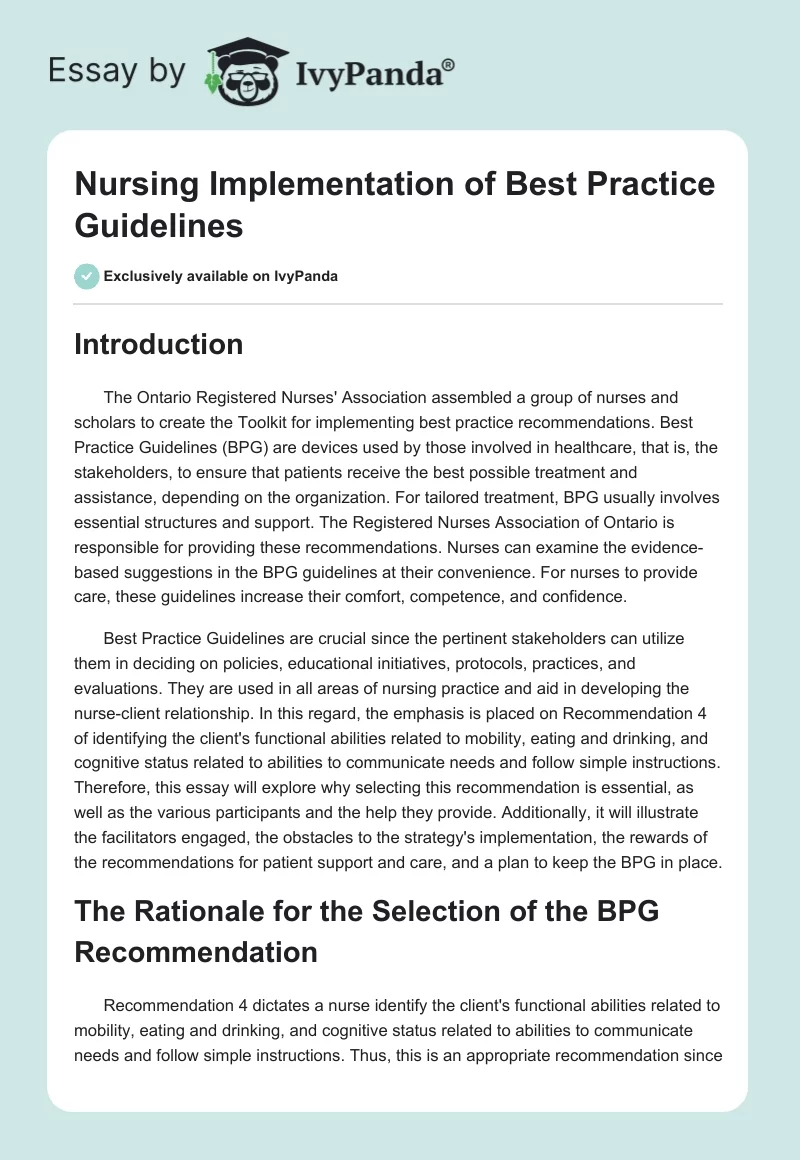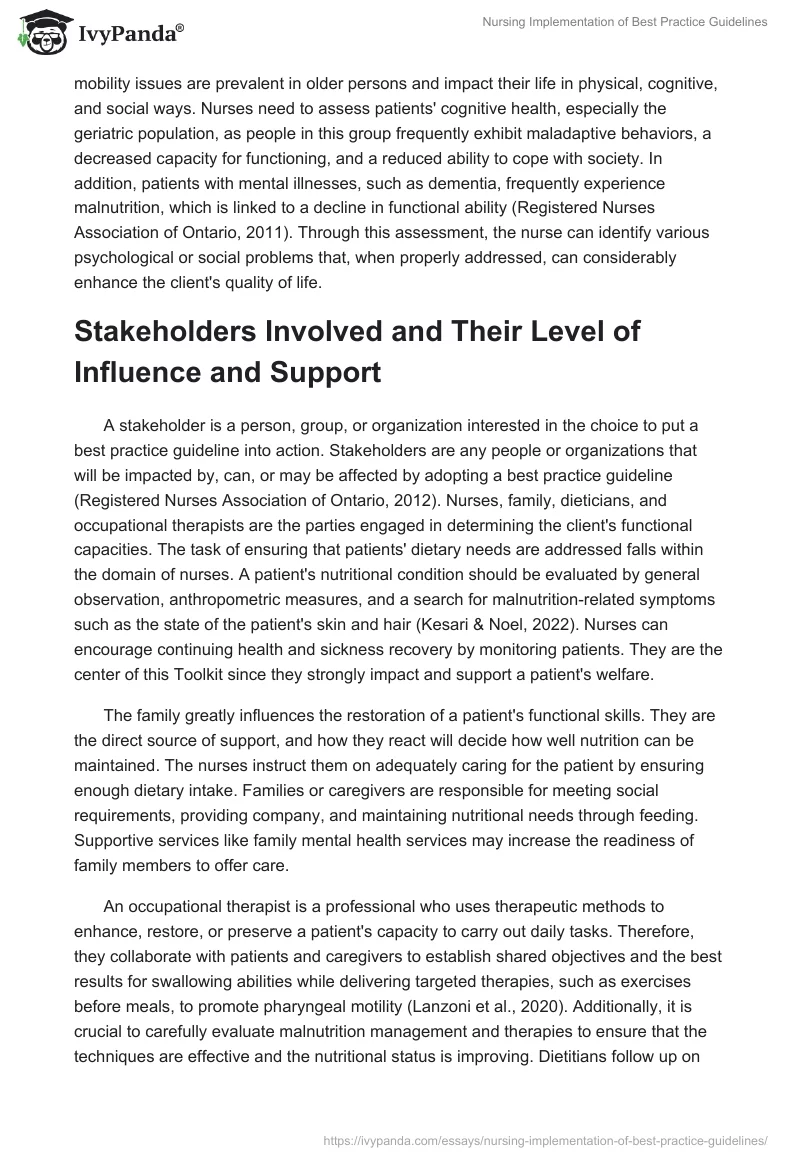Introduction
The Ontario Registered Nurses’ Association assembled a group of nurses and scholars to create the Toolkit for implementing best practice recommendations. Best Practice Guidelines (BPG) are devices used by those involved in healthcare, that is, the stakeholders, to ensure that patients receive the best possible treatment and assistance, depending on the organization. For tailored treatment, BPG usually involves essential structures and support. The Registered Nurses Association of Ontario is responsible for providing these recommendations. Nurses can examine the evidence-based suggestions in the BPG guidelines at their convenience. For nurses to provide care, these guidelines increase their comfort, competence, and confidence.
Best Practice Guidelines are crucial since the pertinent stakeholders can utilize them in deciding on policies, educational initiatives, protocols, practices, and evaluations. They are used in all areas of nursing practice and aid in developing the nurse-client relationship. In this regard, the emphasis is placed on Recommendation 4 of identifying the client’s functional abilities related to mobility, eating and drinking, and cognitive status related to abilities to communicate needs and follow simple instructions. Therefore, this essay will explore why selecting this recommendation is essential, as well as the various participants and the help they provide. Additionally, it will illustrate the facilitators engaged, the obstacles to the strategy’s implementation, the rewards of the recommendations for patient support and care, and a plan to keep the BPG in place.
The Rationale for the Selection of the BPG Recommendation
Recommendation 4 dictates a nurse identify the client’s functional abilities related to mobility, eating and drinking, and cognitive status related to abilities to communicate needs and follow simple instructions. Thus, this is an appropriate recommendation since mobility issues are prevalent in older persons and impact their life in physical, cognitive, and social ways. Nurses need to assess patients’ cognitive health, especially the geriatric population, as people in this group frequently exhibit maladaptive behaviors, a decreased capacity for functioning, and a reduced ability to cope with society. In addition, patients with mental illnesses, such as dementia, frequently experience malnutrition, which is linked to a decline in functional ability (Registered Nurses Association of Ontario, 2011). Through this assessment, the nurse can identify various psychological or social problems that, when properly addressed, can considerably enhance the client’s quality of life.
Stakeholders Involved and Their Level of Influence and Support
A stakeholder is a person, group, or organization interested in the choice to put a best practice guideline into action. Stakeholders are any people or organizations that will be impacted by, can, or may be affected by adopting a best practice guideline (Registered Nurses Association of Ontario, 2012). Nurses, family, dieticians, and occupational therapists are the parties engaged in determining the client’s functional capacities. The task of ensuring that patients’ dietary needs are addressed falls within the domain of nurses. A patient’s nutritional condition should be evaluated by general observation, anthropometric measures, and a search for malnutrition-related symptoms such as the state of the patient’s skin and hair (Kesari & Noel, 2022). Nurses can encourage continuing health and sickness recovery by monitoring patients. They are the center of this Toolkit since they strongly impact and support a patient’s welfare.
The family greatly influences the restoration of a patient’s functional skills. They are the direct source of support, and how they react will decide how well nutrition can be maintained. The nurses instruct them on adequately caring for the patient by ensuring enough dietary intake. Families or caregivers are responsible for meeting social requirements, providing company, and maintaining nutritional needs through feeding. Supportive services like family mental health services may increase the readiness of family members to offer care.
An occupational therapist is a professional who uses therapeutic methods to enhance, restore, or preserve a patient’s capacity to carry out daily tasks. Therefore, they collaborate with patients and caregivers to establish shared objectives and the best results for swallowing abilities while delivering targeted therapies, such as exercises before meals, to promote pharyngeal motility (Lanzoni et al., 2020). Additionally, it is crucial to carefully evaluate malnutrition management and therapies to ensure that the techniques are effective and the nutritional status is improving. Dietitians follow up on nutritional treatments and modify them to meet changing client requirements by speaking with patients and caregivers.
The Barrier to Implementation of the Guidelines and Strategy to Mitigate Its Impact
A significant concern that may hinder the use of the Toolkit is factors connected to guidelines. The gaps in the study are a problem for the BPG’s implementation. The suggestions in the implementation toolkit from the Registered Nurses of Ontario were created using just the data at hand. A practitioner must manage a crisis using their education, expertise, and experience in the lack of evidence. The length of the systematic review considerably impacts implementation, especially if new pieces of evidence are discovered during that period. The organization may lessen it by ensuring they do systematic reviews yearly to stay current. The nursing staff needs a support structure where they can discuss their experiences utilizing innovation rather than using the BPG for effective adoption.
Facilitators and Strategy to Maximize the Impact
A facilitator is a person who assists a group of people in working more effectively together, understanding their shared goals, and developing strategies to accomplish these goals. A nurse can improve their management evaluation of geriatric clients by implementing the guideline. It is crucial to choose an implementation strategy that makes it easier to put new information into practice. As a strategy, health education needs to be interactive or coupled with other interventions. A multifaceted method that typically includes education, such as presentations or passive information sharing, may result in significant improvements in treatment. Therefore, nurses must participate in a full-day instructional session where they will learn methods for incorporating the BPG suggestions into their working environment.
The Benefit of Recommendation 4 to Patient Care and Support
The Best Practice Guidelines’ recommendation number four is beneficial to a patient. People with decreased functional and cognitive capacity, as well as the elderly who are frail, are more likely to experience constipation (Registered Nurses Association of Ontario, 2011). The professionals may comprehend the client better if their functional and cognitive skills are identified. Due to this approach, nurses can create a functional communication chain while providing care, effectively enhancing the nurse-patient and caregiver connection. The fact that nurses have the most direct contact with patients also plays a role in identifying their functional abilities and nutritional status. This recommendation is essential for preventive and early intervention since it highlights important factors for reducing the effects of any potentially major health conditions among the geriatric population. The routine nurse screening aids in accurately evaluating and treating patients’ nutritional conditions (Gbareen et al., 2021). The nurses do a required screening as soon as a patient is admitted to assess what needs to be treated and managed.
Strategy to Sustain the Implementation of the BPG Recommendation
When implementing Best Practice Guidelines, two strategies are used. These are strategies that are workflow- and provider-focused. Workflow-focused strategies entail removing barriers that limit a nurse’s ability to practice competently. Provider-focused methods seek to remove obstacles that impede the involved healthcare Association, in this case, the Ontario Registered Nurses. Workflow-focused techniques entail disseminating learning materials to the nurses to
guarantee accurate and systematic execution of the guidelines. As a result, it is a critical approach to take into account for the fourth recommendation. This might take the form of conferences and earlier research materials in the clinical setting. Thus, this technique may be realized by planning seminars, educational training, conventions, and meetings. This kind of exposure increases the social connection between nurses and their coworkers. Although participants in these forums can freely discuss their positive and bad experiences, this exposure makes it easier to implement suggestions four and other recommendations. Once the procedure is correctly followed, the nurses can ensure the patients benefit the most from it.
Conclusion
The Registered Nurses of Ontario must follow Best Practice Guidelines to guarantee that patients get high-quality treatment. The review outlines the challenges encountered in ensuring its implementation, as well as the strategies and facilitators. For nurses to become competent, they need as much experience and training as feasible. These rules are essential for maintaining the nursing practice’s efficiency and fostering patient relationships. In order to effectively apply these recommendations, it is crucial to include all responsible stakeholders.
References
Gbareen, M., Barnoy, S., & Theilla, M. (2021). Subjective and objective nutritional assessment: Nurses’ role and the effect of cultural differences. BioMed Central Nursing, 20(1). Web.
Kesari, A., & Noel, J. Y. (2022). Nutritional Assessment. Nih.gov; StatPearls Publishing. Web.
Lanzoni, A., Romano, E., Ranhoff, A. H., Clark, E. G., Holter, M. K., & Jørmeland, C. (2020). Occupational therapy in rehabilitation settings. Occupational Therapy for Older People, 77–99. Web.
Registered Nurses Association of Ontario. (2011). Prevention of Constipation in the Older Adult Population. Toronto, ON: Registered Nurses Association of Ontario. Web.
Registered Nurses Association of Ontario. (2012). Toolkit: Implementation of Best Practice Guidelines. (2nd ed). Web.


